Apple patents involve radio services, simulcasting
Two Apple patents at the US Patent & Trademark Office indicate the company is looking into ways of beefing up radio services in other iOS devices besides the iPod nano -- and perhaps teh Mac.
Patents 20100291861 and 20100292816 are credited to Apple's Freddy Anzures and team mates Henry Mason and Lucas Newman. The patents were originally filed in Q2 2009. Assignee names don't have to appear on patent applications until they've been grantted.
Patent number 20100291861 is for content selection based on simulcast data. Per the patent a computer system receives information snippets from a mobile device. The information snippets are extracted from a simulcast of a data stream of a radio broadcast received on the mobile device. The system identifies content metadata from the information snippets. The content metadata describes one or more features of the radio broadcast.
The system selects a radio station from a radio station repository based on attributes of the radio station. One of the selection criteria is that the attributes of the radio station match at least a portion of the content metadata. The system presents a reference to the radio station to the mobile device as a recommendation.
Patent number 20100292816 involves processing simulcast data. Per the data, a mobile device receives a radio simulcast of streaming data and content. The mobile device extracts metadata from the radio simulcast. The mobile device identifies a communication channel to a content provider by comparing components of the metadata with reference data.
The mobile device presents a user interface for connecting to the content provider through the communication channel. The mobile device also records the metadata with a time stamp and provides a user interface for displaying the data and time of content received. The inventors on both patents are Freddy A. Anzures, Henry Mason and Lucas Newman.
Here's Apple's background and summary of the inventions: "In some radio broadcasting protocols, data can be transmitted simultaneously (simulcast) with broadcast content. For example, Radio Data System ('RDS) is a simulcast protocol that allows data to be transmitted simultaneously with content in FM (Frequency Modulation) broadcast. RDS operates by adding data to a baseband signal that is used to modulate a radio frequency carrier. In some implementations of RDS broadcasting, the baseband signal has a number of components. Normal modulated audio signal that includes a left plus right (L+R) component is transmitted from 0 to 15 kHz (relative to the baseband). A stereo difference signal (L−R) component is transmitted on a 38 kHz subcarrier. RDS information (e.g., data) is transmitted on a 57 kHz subcarrier. Data are modulated and transferred at 1187.5 bits per second. RDS data can include free-form text that, after demodulation, can be displayed on a display device.
"A computer system receives information snippets from a mobile device. The information snippets are extracted from a simulcast of a data stream of a radio broadcast received on the mobile device. The system identifies content metadata from the information snippets. The content metadata describes one or more features of the radio broadcast. The system selects a radio station from a radio station repository based on attributes of the radio station. One of the selection criteria is that the attributes of the radio station match at least a portion of the content metadata. The system presents a reference to the radio station to the mobile device as a recommendation."














